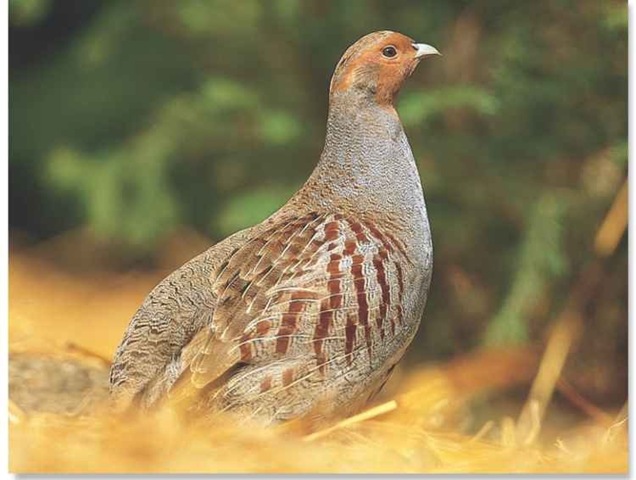ORDER
Galliformes
FAMILY
Phasianidae
GENUS & SPECIES
KEY FEATURES
Male’s distinctive call has been compared to the grating squeak of a rusty gate being opened
• During severe winter weather, the partridge will roost by burrowing into the snow
• Even with broods of up to 20 chicks, only about 50% of the juveniles in a partridge family survive
WHERE IN THE WORLD:
Found throughout Europe east to Turkey, Russia and western Siberia; also well established in the northern United States and southern Canada

Lifecycle
The gray partridge is an alert, wary bird that usually travels in groups called coveys; when flushed, the covey rises together and then the birds regroup.
Habitat
The gray partridge prefers open, grassy areas in a cool, dry climate. Unlike other game bird species, however, the partridge can tolerate intensive agricultural development and actually seeks out habitats, such as farmland, on which most of the land is cultivated. Small, heavily cultivated farms of about 100 acres particularly appeal to the partridge. On these farmlands, the gray partridge requires an abundance of protective fence rows, shelter belts and undisturbed roadside cover. It uses these areas for escape routes and also for nesting, resting and winter cover. After a harvest, ground stubbles serve as feeding and roosting areas for partridge coveys. Brood numbers are limited by the abundance of insect prey for chicks, the amount of nesting cover and the level of predators present while nesting.
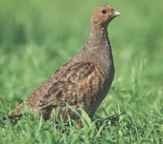
A Class in the grass A proud partridge struts across an open field.
Food & feeding
Gray partridges eat mainly weed seeds, cultivated grains and green leafy plants.Young birds also feed on insects such as crickets and grasshoppers, but animal foods make up only about 10% of an adult partridge’s diet. During the spring and early summer, partridges feed mainly on green leafy material, including dandelions, small grains and assorted grasses. In the summer and fall, weed seeds of plants including foxtail, wild buckwheat and linotweed are abundant sources of food. Cultivated grains, such as wheat, corn, oats and barley are another essential food source:such grains can account for over one-third of the bird’s summer diet and become increasingly important through the winter In many areas of the partridge’s range, field stubble and waste grains (especially corn) constitute nearly all of its winter food supply.
Behavior
The gray partridge lives in a flock called a covey for 7-8 months of the year A covey consists of a family group that includes last year’s nonbreeding birds, or of two family groups that have joined to form a larger group. Such flocks can sometimes number 20 or more birds.
During warmer weather, partridges are most active in the morning and late afternoon, resting in cover during midday. Their range is very limited and usually does not exceed 0.25 mile, although the birds may fly as much as 0.5 mile in winter to search for food. The gray partridge covey feeds and roosts together and breaks up only during the breeding season.
Gray partridges have the unique ability to survive heavy winters in open, unprotected fields containing minimal cover. During severe weather; the birds “roost” in depressions in the snow, or by burrowing in. Partridges normally leave their winter roosts only during the warmest part of the day when they fly out to the fields to feed. Juveniles are especially vulnerable in cold weather:
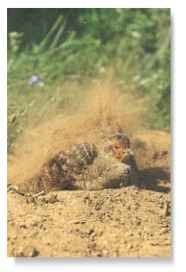
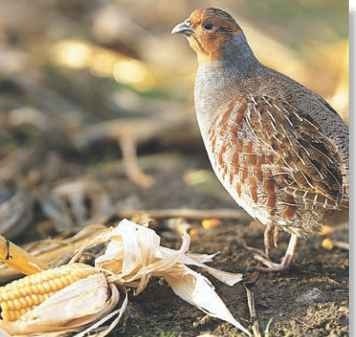
The gray partridge’s scientific name, Perdix perdix, is known as a tautonym, which means that both parts of the scientific name are the same.
The gray partridge’s nickname, “hun,” is short for Hungarian partridge.
Bird “bath” A gray partridge shuffles its wings to flick dust on its feathers to absorb excess oil.
Conservation
Gray partridge populations have declined by up to 90% in some countries due largely to habitat destruction. The species has become extinct in Norway and is on the verge of extinction in Ireland and Switzerland. An increase in predators has hurt populations; because the partridge is a prize game bird, hunting is also a threat.
Breeding
Gray partridges begin the slow process of courtship in early winter Both sexes perform numerous dramatic displays, including circling, neck-stretching and running with head lowered. In March, the males in a covey begin crowing with their “rusty gate” call, to advertise their presence, especially in the morning and evening. Crowing then leads to ritualized fighting between the males, which fly and peck at each other. Eventually, one male leaves the area, and the victorious bird remains to try and attract a female.
Following mating, usually in late April, the female builds the nest while the male stands guard nearby. The nest is usually located in grasses in open country or along roadsides, fences, hedgerows, ditches and banks.
Shortly after the nest is complete, the female lays her first egg. She continues laying one egg per day until her clutch of 9-20 olive-colored eggs is complete. The female incubates the eggs, often covering them with grass and leaves to hide them from predators when she leaves the nest to feed.
After about 25 days, the downy young hatch. Both parents care for the chicks, taking them out to feed on insects and green vegetation. Brood mortality is high, however; and nearly 50% of the brood may be lost before the chicks are two weeks old, mainly to predators, such as foxes. After about two months, the young partridges are able to fly, but they usually remain with their parents through fall and winter until the following breeding season.
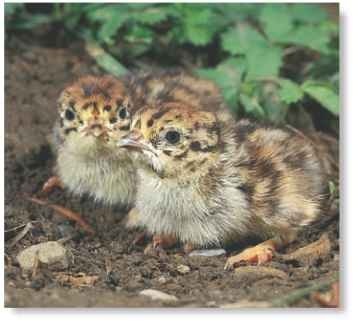
Plenty of ear Corn is a staple of the gray partridge’s diet in many locales.
partridge pairs

Cozy covey…
Partridges form small groups of 10-15 birds called coveys, which stay together until the start of the breeding season.
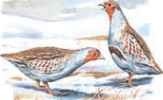
Courtship rituals…
Partridge pairs must go through an elaborate courtship ritual before finally pairing off for the mating season.
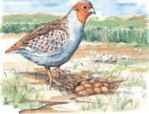
Protective mama…
The female takes great care to build her nest in a protected area, filling a shallow depression behind a hedgerow with leaves and grass.
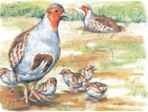
Proud papa
The male partridge broods the first-hatched chicks while the female incubates the remainder of her clutch of eggs.
PROFILE
Gray Partridge
If forced to take flight, the partridge attempts a hasty takeoff with its short wings, landing only a few hundred feet from its point of departure.
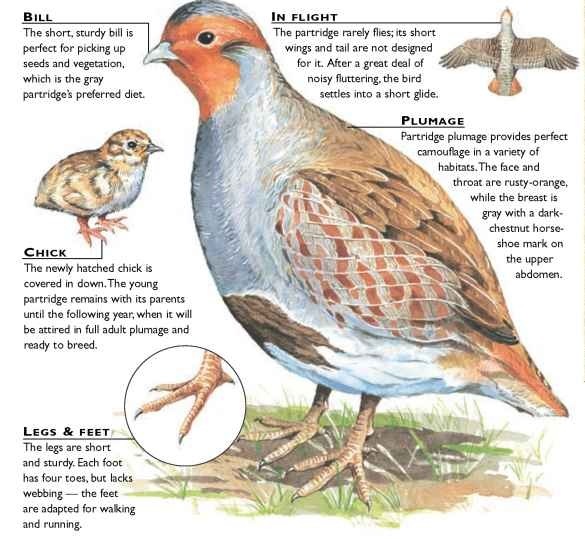
Creature comparisons
The black wood partridge (Melanoperdix nigra) measures 9.5-10.5″ and is slightly smaller than the gray partridge. Both partridges have plumage befitting their names: the black wood partridge is almost entirely black and its cousin’s breast is gray. The black wood partridge occurs singly or in pairs in the dense undergrowth of forests or woodlands; the gray partridge prefers to group together in coveys £ray in open areas, farmlands and brush. partr-idge
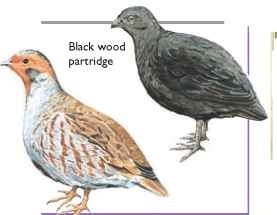
| VITAL STATISTICS | |
| Weight | Up to 1 lb. |
| Length | 11-12″ |
| Wingspan | 17.5-19″ |
| Sexual i Maturity | 1 year |
| Breeding Season |
April-September |
| Number of Eggs | 9-20 |
| Incubation Period | 24 days |
| Fledging Period | 40-60 days |
| Typical Diet | Adults: mainly weed seeds, grains and leafy plants; young: insects, such as crickets and grasshoppers |
| Lifespan | Unknown |
RELATED SPECIES
• Partridges belong to the Phasianidae family, which includes pheasants and quails. Members of this family have plumage that is commonly brown, gray and heavily marked. There are 94 species of partridge in 19 genera, ranging all over the world, from Africa and Europe to Asia and Australia. The family includes the red-legged partridge, Allectoris rufa, and the crested wood I partridge, Rollulus roul.
